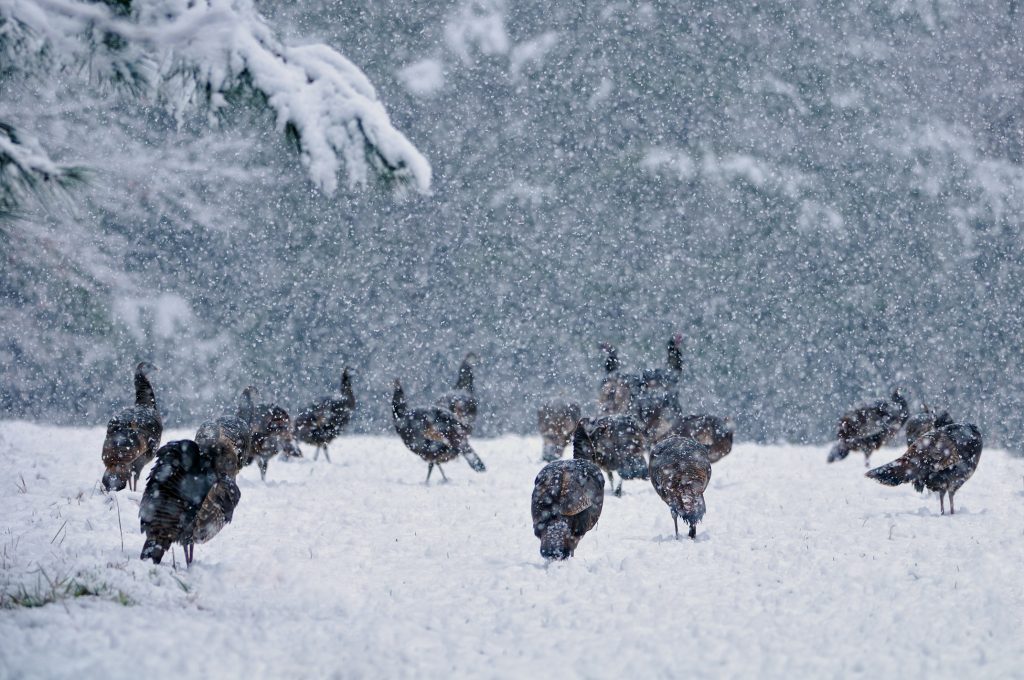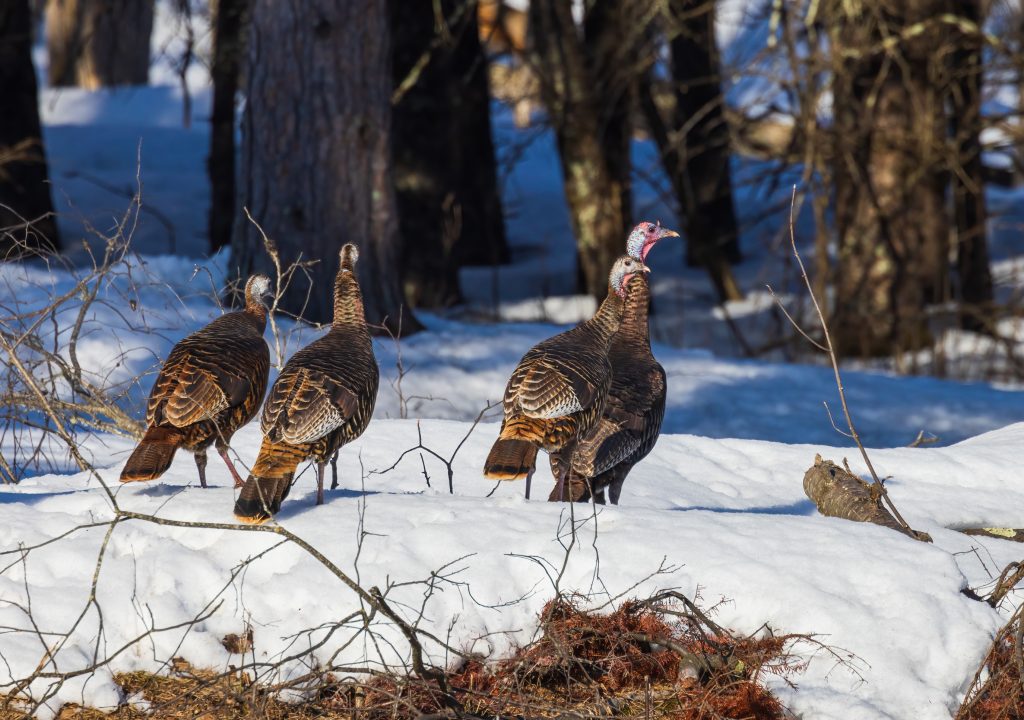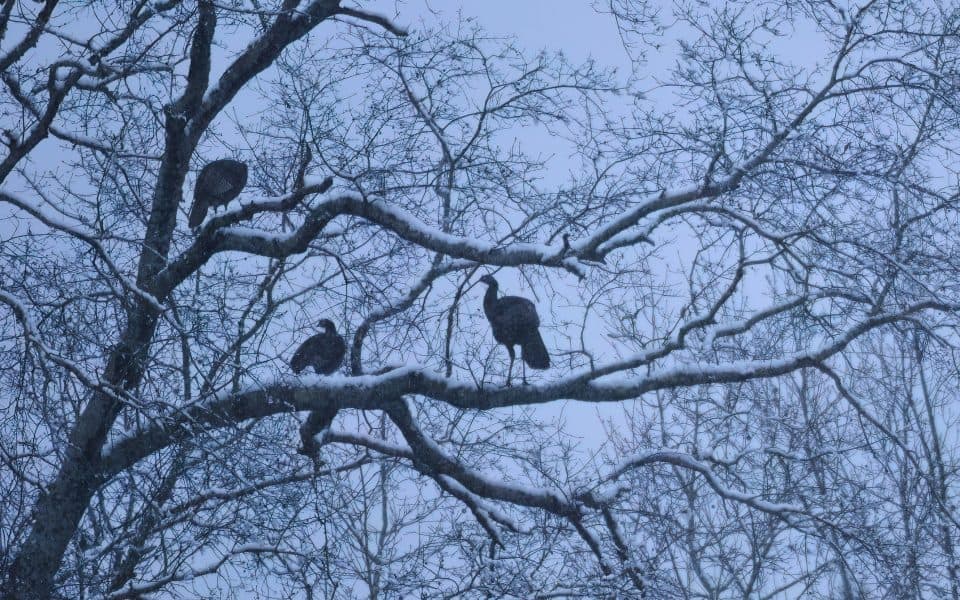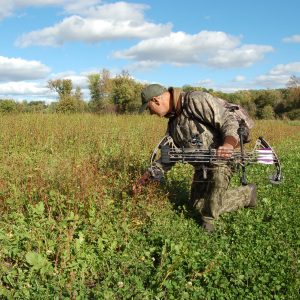The empty, derelict barn we huddled in offered little protection from the cold, but did partially break the wind that blew blankets of snow diagonally across our obscured view. Nearly at the limit of that view stood a massive cottonwood and on its branches, large black shapes looking vaguely like headless turkeys clung and bounced like Christmas ornaments in an earthquake. There would be no turkey hunt today.
The following morning came, sunny but cold and with 16 inches of fresh powder blanketing the landscape. Our hopes weren’t very high but we’d already burned one day and only had three left on our Wyoming hunt so we endeavored to persevere. It was spring, but the conditions offered ample insight into just how wild turkeys adapt to winter, and sometimes even thrive in harsh winter conditions. Like we did on that hunt, turkeys make the most of what they have. Let’s take a closer look at what that means and how we can make it better for them.
Wild Turkey’s Resilience
Before we do however, I’ll offer a couple examples of just how hardy and resilient wild turkeys can be. The first is from a west Texas ranch where halfway up the ladder to my shooting house I could see over every living plant, which consisted mostly of cedar and a few scrawny mesquite bushes. I saw turkeys there and when I asked my guide where they roosted he said, “On the power poles.” It’s hardly ideal, and perhaps a bit perilous, but it sufficed.

Tes Jolly
The other example is from my home state of Maine where I was helping to trap and transfer some birds to the town of Bridgton, in the northwestern corner of one of Maine’s two southernmost counties. I remember the assistant regional biologist joking, “We’re going to sacrifice some turkeys in the name of science.” Based on all the existing data and everyone’s experience at that time there was little hope for their survival; but you don’t know unless you try. We tried and the birds exceeded everyone’s expectations. Nearly 30 years later, huntable populations exist over 200 miles farther north, in places where the moose outnumber the deer, and in some places the people.
Wild Turkey Habitat
It really comes down to habitat – especially winter habitat as that is often a limiting factor. Climate influences that and while empirical science has yet to catch up, the latest Zeitgeist at least suggests more favorable conditions in the future. Either way there’s not much we can do about climate, but there’s plenty we can do about turkey habitat. The birds occur where they exist and they thrive where it’s more favorable. It’s also important to bear in mind that habitat variables are often interrelated, a fact that land managers can often capitalize on.
Turkey Roosts
The basic elements for turkey habitat are food, water, cover and suitable roost sites. In the latter case, anything that gets the birds up off the ground and away from terrestrial predators is beneficial. A prime example is bottomland hardwoods.
It is sometimes said in the south that turkeys like to roost where they can hear their droppings hit the water. That’s probably not a deliberate effort. Rather, it’s where the largest trees remain, because of either environmental or logistical limitations on cutting in wetlands. Either way, it’s a boom for the birds. When it comes to maintaining these stands as roosts, size does matter and older hardwood stands with bigger trees are always better, but not the best.
One thing turkeys must endure throughout much of their winter range is cold temperatures that sap heat and require birds to burn more energy, whether feeding or roosting. Wind sucks body heat even more rapidly so anything that breaks that wind can help, and evergreens do that better.

Linda Arndt
I’m a first generation turkey hunter, one of those now old sots who were around when the first modern New England turkey seasons were implemented. Unless we happened upon a transplant from the southeast or Midwest, there was nobody around to teach us how to hunt these recently restored birds. It was a steep learning curve, but I figured out pretty quickly where to find roosts, and after 40 years of chasing gobblers it still holds true: Look for the tallest white pines.
That might not seem so enlightening until you consider that most of central and northern New England is covered in mixed forest. That means turkeys have ample choice in terms of the size and species of trees in which to roost. They roost in oaks with their relatively lateral branches and even maples with their more diagonal branches when that’s all that’s available. They roost in spruce and fly up into fir, but if there are white pines, that’s where you’ll find them; but why?
First, they’re tall. That gets the birds up and away from terrestrial predators. Second, their growth pattern provides a network of sturdy branches that are relatively parallel to the ground, making ideal perches. Third and perhaps most important, they retain their dense foliage throughout the year. This provides protection from the elements and avian predators.
Unlike many other coniferous evergreens in the north, white pines grow on the south-facing slopes rather than the north. These areas receive more sunlight and are better protected from prevailing winter winds.
Bottom line: turkeys will do alright in bottomland hardwoods, but will do better if you can provide at least some mature softwoods, and better still if those are in protected areas. You can even do that on lands managed largely for timber harvest by maintaining uneven-aged rotations. Again, younger pines will certainly suffice, but if you can maintain some older stands you’ll have more turkeys.
Softwoods offer another advantage that becomes more important in areas of heavy snowfall. As noted above, turkeys now occur in areas where the average annual snowfall may exceed 72 inches. A single storm could bring a foot or two. Fluffy, white powder may be nice to look at but it makes getting around tougher for turkeys. They’ll plow paths if they have to but that burns lots of energy and makes them more vulnerable to predators. In addition to breaking the wind, older softwood stands intercept falling snow, effectively reducing snow depth underneath, improving both travel and predator avoidance. That’s why deer often favor the same areas. Unlike deer, which tend to be much more faithful to traditional wintering areas and will return to winter yards even after they’ve been cut, turkeys are less finicky. They’ll find the best roost trees eventually.
Sometimes it seems bad weather just follows me, and that appeared to be the case on a Nebraska hunt where my hunting party and I, and the turkeys we sought were subjected to cold, snow and high winds. But even the worst conditions provide an opportunity for learning. Setting out for an afternoon hunt my companion and I opted to seek the shelter of a deep draw where we nestled in against the bole of a big cottonwood.
All was quiet until an hour or so before sunset when we noticed movement on the bluff above. First one bird then another, and another walked to edge, paused momentarily then sailed down into the bottom. It soon seemed more like D-Day as single birds, groups and then flocks parachuted into the bottom, all marching toward the larger roost trees.
Throughout much of the western plains, the cottonwood is king. That’s largely because it’s the only tree large enough to represent a reliable roost. Farmers and ranchers understand the importance of cottonwoods as a wind break, to prevent erosion and provide shelter. Turkeys literally flock to them, particularly when aspect and topography protect them. If you’re going to plant and/or maintain them, seek the best locations.
Winter Cover for Wild Turkeys
Roost sites aren’t the only important type of winter habitat. Cover is important year round but especially in winter. As already alluded to, anything that breaks the wind and provides thermal protection is helpful. Here too, evergreens are better. Cedar may be a nuisance to ranchers and farmers, but patches provide protection so try to leave some when you can.

Lina Arndt
Shelterbelts are a very effective way to protect habitat and wildlife by providing shelter on the leeward side. The majority should be oriented against prevailing wind but different orientations offer options for variations. In uneven terrain, mid-slope is a better option as gullies and draws are generally more protected and steeper areas more exposed. To the extent possible, try to maximize height by choosing the right species, and length; and avoid gaps.
Wild Turkey Winter Food Sources
Until now we’ve largely neglected a critical winter habitat variable: food. In addition to simply not freezing to death, turkeys also need to eat, and winter is when natural food is scarcest and least nutritious. We can provide that, and we’ll start with the low-hanging fruit.
Supplemental feeding includes both the intentional and unintentional. It is sometimes said that if it wasn’t for dairy farms we would not have turkeys in northern New England. That was probably more true during the re-establishment phase but even now we wouldn’t be able to maintain present population levels without their help. Silage piles are a critical food source during severe weather periods, which is why turkeys often congregate by the dozens, if not hundreds, around dairy farms during the winter, and pick at cow patties on farms and ranches.
Much the same is true for bird feeders in suburban and rural residential areas. Homeowners may put the seed out for other species but if there are turkeys in the ‘hood’ they’ll find it, and can become an attractive nuisance. Regardless, if it helps more birds through the winter, it’s a plus.
Speaking of nuisances, I know my rancher friends are going to cringe when I say this but hay bales can be an important winter food source for western birds. Ranchers don’t like it because the birds learn to tear the plastic off bales (which they also do to silage piles) allowing moisture in. Fortunately, there’s a simple solution, if you run livestock but still want to maintain your flock and not have them ruin all the food you rolled up for cattle fodder, set a few bales aside for the birds. It won’t take them long to find a reliable food source, and it might keep them away from the dedicated cattle fodder.
In agricultural areas, waste grain can be a boom for the birds. If you’re the grower, or you have a good relationship with them, encourage sloppy harvest practices, at least in a few areas. A little spillage out of the hopper or a few rows left un-harvested gives the birds a bonus.

Bob Humphrey
Programs like CRP, set-aside and even simple rotations are also beneficial. Fields left fallow fill with fall foods like weed seeds. CRP plantings are designed to do this by specifically adding seed-producing plants, not to mention cover.
In some ways Texas turkeys have it easy. There’s usually enough natural food to get by on but on managed lands they get served twice a day. If you’re one of the people who manages those lands, mostly for deer, and you also like turkeys, keep that in mind. Turkeys come to depend on that food and if you stop providing the corn as soon as the deer season ends, they’ll be forced to forage for what’s left.
Mast orchards are usually established for deer but can be equally beneficial to turkeys, and in both cases, the more variety the better. Different species and families of mast-producing trees like oaks provide nuts at different times of the fall and winter, and sometimes more or less in different years. White oak varieties generally produce annually, under optimum conditions. Red oak acorns take two years to mature, making them less reliable in poor years but capable of producing a bumper crop in good years. Even soft mast species like crabapples may persist well into winter.
Food plots are yet another way. Here too, most of the attention goes toward deer but you can double your effectiveness with the right crop. Chufa is a good option where you don’t get deep snow, if you can keep the turkeys from finishing it all off in the fall. Plants with big seed heads like milo and millet will persist and provide food throughout the winter. It’s also not a bad idea to have some perennial clover plots. They’ll be producing greenery long before you can plant annuals, and at a critical nutritional period (late winter/early spring) for both turkeys and deer.
If you’re intensively managing habitat for deer you may be inclined toward removing so-called “undesirable species,” but don’t be too hasty in removing anything that doesn’t grow nuts.
When winter food is scarce, turkeys will feed on whatever is available, including the seeds and catkins of trees like ash, birch and aspen. Furthermore, these seeds may persist well into winter and often lie on top of the crusted snow that covers up the acorns.
Predation
I’m not a strong advocate for predator control because it often comes down to single-species management: reducing one species to benefit another, so we can kill more of the latter. Ecologically, that doesn’t pass the straight face test. However, there is a tipping point where some predators, like eastern coyotes, are unnaturally tipping the balance decidedly in their favor to the detriment of natural populations. Without natural population controls we sometimes need to intervene, and a well regulated predator control program can help more turkeys make it through the bottleneck of winter.
Conclusion
As their scaly reptilian-looking legs suggest, turkeys and their progenitors have been around a long time. And as the birds at the northern limit of the species’ range demonstrates, natural selection continues to test the boundaries. Like whitetails, wild turkeys are an incredibly adaptable species that continue to find ways to persist where nobody thought they could. We can’t maintain an artificially high population level indefinitely because like water, it will eventually find its own level. But as with deer, if we can increase the carrying capacity of the land, we can support more and healthier birds. And that’s a good thing.






